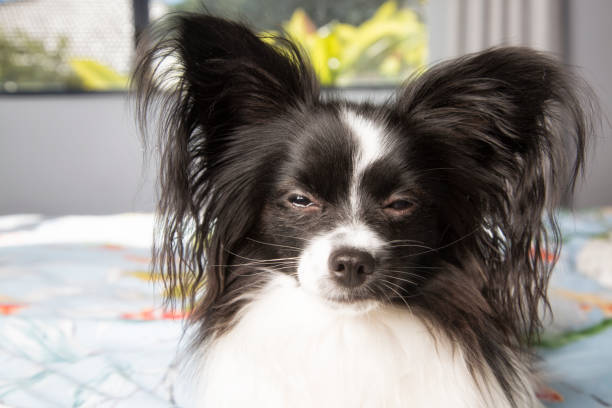Toy Spaniels come in two different types: the Papillon is characterized by its well-feathered erect ears, while the Phalène has long, lop-eared ears typical of Spaniels. Both types are among the smallest dog breeds in the world and are kept purely as companion dogs. You can find out whether the lovable toy spaniels suit you in a brief breed overview of both variants.
Unmistakably Cute: The Distinguishing Features of the Continental Toy Spaniel
Papillon and Phalène toy spaniels are among the smallest and lightest dogs in the world: they usually weigh less than 4 kilograms and reach a height of 20 to 30 cm at the withers; The breed standard specifies an ideal height at the withers of 28 cm. They are bred in two weight classes, with a weight of 1.5 kilograms being the prescribed minimum weight for adult animals.
- Lightweight weighs between 1.5 and 2.5 kg
- Heavyweights weigh 2.5 to 5 kg
The Continental Toy Spaniel from head to tail: Which ear type should your toy spaniel have?

The Continental Toy Spaniel’s most distinctive feature is its large ears. In both varieties of the breed, the ears are set far back on the head, showing the natural shape of the skull. The thin ear flaps are slightly rounded at the tips and the backs and edges of the ears are covered with long, fine top hair.
- The Phalène (literally translated moth) has flexible hanging ears with a long, wavy topcoat.
- With the papillon (French for butterfly), the wide-open auricles protrude at an angle from the head. They are surrounded by fine, shorter hair in front, and the back of the ears has long hair so that some dogs have fine flags hanging down.
Further characteristics of the toy spaniel at a glance
- The head is smaller and shorter than other Spaniel breeds, with a well-defined stop at the bridge of the nose. The muzzle is shorter than the skull and tapers towards the tip. The rounded nose, which is black in all dogs of the breed, is striking.
- In some toy spaniels, the tongue often hangs out of the mouth, which is considered a serious fault in the breed.
- The deeply set almond eyes, which are relatively large in relation to the head and, according to the FCI breed standard, should be as dark as possible are characteristic of the dog’s friendly facial expression.
- The upper profile line of the body and the loins are slightly arched. The chest is deep and the lower profile line is slightly tucked up.
- The legs are described as straight, strong, and fine. The dogs have long bunny toes on their hind paws.
- A fine flag of guard hair adorns the long tail. When excited, it is carried bent over the back.
Coat and colors of the Continental Toy Spaniel
- The Toy Spaniel’s relatively dense fur is wavy and medium-long. The face, muzzle, and paws have short hair, and the ears and the backs of the legs are finely feathered. The outer hair grows the longest on the tail.
- The basic color of all dogs is white, but they only have a blaze on their heads.
- Any color is permitted on a white background. Solid white toy spaniels are almost never found.
Common colors are black and white, brown and white, red and white, yellow and white, and tricolor with a light brown burn. - Solid red and sable papillons are also more common in the United States.
How do distinguish the toy spaniel from similar dog breeds?
- The Russkiy Toy Terrier looks similar to him. He wears short, mostly brown hair with flags on his ears and tail.
- Pomeranians have fluffy fur with a thick undercoat.
- The Pekingese’s coat and face differ significantly from the toy spaniel’s appearance.
- Long-haired Chihuahuas can look confusingly similar to the small spaniels. They come in all colors and, in contrast to the miniature spaniel, have a slightly rumpled, short snout.
The History of the Continental Toy Spaniel: The Dog of the Nobility and the Rich
Toy spaniels were depicted in paintings and family portraits of nobles in England, France and Belgium as early as the 13th century. Ancient depictions from before the 17th century only show Phalènes with floppy ears. In 1905 a uniform breed standard was established for both toy spaniel types.
Why continental?

The origin of the breed is officially attributed to France and Belgium. In French-speaking courts, the animals were multiplied over the centuries without any significant change in appearance. English nobles also kept red and white Phalène toy spaniels and contributed to the preservation of the breed. Not much is known about the origin of the toy spaniel – it is possible that European hunting dogs (cocker spaniels) were selected for size and character in order to breed a companion dog with spaniel attributes. Crossing German Miniature Pinschers or Asian Miniature Dogs could also have contributed to the development of the two varieties.
The Nature of the Continental Toy Spaniel: Delicate, But Not Sensitive
Miniature spaniels have been kept as lapdogs for centuries and do very well with their owners. When they live in a family circle, they form a close bond with all family members and get pats from all pack members every day. Despite this, the small domestic dogs are full-fledged spaniels and like to fool around, explore and play a lot.